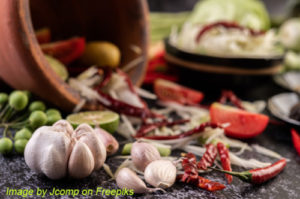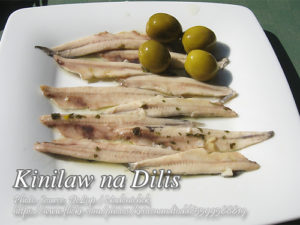Sinuglaw is a combination of fish ceviche and grilled pork, mixed together to make a wonderful tasty dish. This can be an appetizer, pulutan, or main dish. And when it comes to the ingredients, I think you will wonder and will become curious of the fruit called tabon tabon. It’s only indigenous to places in Visayas and Mindanao. So those living in Luzon are not familiar with it, the fruit is oval in shape and the color is brown.
It resembles the chico fruit but when you slice it the core looks like a walnut or like a brown colored brain. It is said to remove fishy taste and odor and prevents upset stomach. Since the fish is raw and only marinated in vinegar, you really need to remove the fishy odor and taste using the tabon tabon. But you can substitute it with grated coconut if none is available in your area.
Sinuglaw: A Taste of the South, a Bowl Full of Memories
I still remember the first time I tasted sinuglaw. It was during one of our summer trips to Cagayan de Oro, where my Tita Maribel lives. The sun was relentless, and we had just come back from a long morning at the beach. My cousin Jun-Jun fired up the grill in the backyard while Tita was already in the kitchen, slicing fresh tuna she picked up that morning from the wet market. That’s when I saw her open this strange brown fruit I had never seen before—tabon-tabon.
“Pangtanggal sa lansa,” she said with a smile, as she scraped the insides of the fruit into a bowl of vinegar. I was skeptical, but what came out of that kitchen was unlike anything I’d tasted before.
What is Sinuglaw?
Sinuglaw is a beautiful mash-up of two words: sinugba, which means grilled meat, and kinilaw, or raw fish cured in vinegar. Together, they form a dish that’s both smoky and tangy, fresh yet hearty. It’s commonly served as a pulutan with ice-cold beer or as a main course during family gatherings in many parts of Mindanao and the Visayas.
This unique Filipino fusion reflects how practical and inventive our cuisine can be—taking what’s available locally and turning it into something unforgettable.
Ingredients that Make This Dish Stand Out
What sets this dish apart isn’t just the combination of grilled pork and ceviche-style fish. It’s the subtle details—like the punch of native lime (biasong or calamansi), the heat from siling labuyo, and that mysterious tabon-tabon fruit.
Now, I know not everyone can get their hands on this indigenous ingredient. It’s native to certain Visayan and Mindanaoan provinces and looks like a chico on the outside. But once you slice it open, the inside resembles a small walnut or, as my brother jokingly called it, “a mini brown brain.” Strange appearance aside, it works wonders. It removes the fishy smell, adds a layer of earthiness, and even helps prevent an upset stomach. A natural food science marvel, if you ask me.
In Luzon, where tabon-tabon is rarely seen, grated coconut works as a solid backup. Just mix it with the tuna before combining it with the rest of the ingredients. It gives the same creamy balance, though the flavor profile changes slightly—still delicious in its own right.
How to Make Sinuglaw Like a Pro
When my uncle Tito Eddie prepares this dish, he insists on three things: fresh fish, hot charcoal, and cold vinegar. According to him, these three elements make or break the dish.
Start by grilling pork chops until they’re slightly charred outside and juicy inside. Let them rest before slicing them into cubes. The smokiness from the grill adds depth that balances out the acidity of the vinegar and lime juice.
For the tuna, or whatever firm white fish you have, make sure it’s sushi-grade or extremely fresh. Dice it evenly and mix it gently with thinly sliced ginger, onions, green onions, and chopped chili. This isn’t the time to rush—let the vinegar “cook” the fish slowly, just enough to make it opaque without turning it rubbery.
Once your fish and pork are ready, it’s time to mix. Pour in the vinegar and citrus juice, then fold in the tabon-tabon mixture. Salt and pepper to taste, and most importantly—let it chill before serving. The flavors develop better, and you get that crisp, refreshing kick that makes the dish perfect on a hot day.
A Dish That Tells a Story
Like many Filipino dishes, this seafood and pork combo tells a story of resourcefulness and culture. It speaks of backyard grills, of relatives sharing stories under mango trees, of makeshift tables in the province lined with banana leaves and overflowing with food.
When my sister Aileen visited Davao last year, she messaged me right after trying the local version of this delicacy. “You have to learn how to make this,” she said, “It tastes like summer and home.”
I couldn’t agree more.
Sinuglaw is More Than Just Food
More than just an appetizer or pulutan, this classic coastal dish is a reminder of how flavors can connect generations. It’s about using what’s around you—fresh seafood, a bit of pork, a fruit most of the world doesn’t even know about—and turning it into something bold and memorable.
So the next time you’re thinking of what to serve for a weekend get-together, or you’re just craving something a little different, give sinuglaw a try. You might not have grown up with tabon-tabon or grilled meat and ceviche in one bowl—but once you taste it, it just might feel like home.
How to Make Sinuglaw
Ingredients
- 100 grams ginger julienne
- 100 grams onions julienne
- 25 grams leeks julienne
- 15 pcs bird's eye chili peppers minced
- 1/2 kilo fresh tuna fillet or blue marlin fillet cut into cubes
- 1/2 kilo pork chops seasoned with salt, pepper and calamansi
- 300 ml coconut vinegar
- 2 pcs native lime
- 1 pc tabon-tabon or 1/4 cup grated mature coconut
- 5 Tbsp coconut vinegar
Instructions
How to make sinuglaw:
- Grill pork chops until well done. Slice into cubes and set aside.
- In a small bowl, combine ginger, onions, leeks, chili pepper, fresh fish and grilled pork. Add in about 300 ml vinegar.
- Cut native lime and squeeze the juice into the mixture.
- In a separate bowl, scoop tabon-tabon into small pieces with a spoon. Add about 5 tablespoon vinegar.
- Toss vinegar mixture into the sinuglaw mix. (In case you can't find tabon tabon , you can use use grated coconut. But the procedure is slightly different, you have to mix the grated coconut on the tuna fillet cubes before tossing it in the sinuglaw.)
- Then mix all the ingredients together. Season with salt and pepper. Chill before serving.
Notes
Cooking Tips:
Use Only the Freshest Fish
Since sinuglaw uses raw fish, freshness is non-negotiable. Choose sushi-grade tuna or any firm white fish with a clean, ocean-like smell and vibrant color. If the fish smells overly “fishy” or looks dull, it’s best to skip it—freshness is the key to both flavor and food safety.Grill the Pork Well, But Don’t Dry It Out
Aim for a nice char on the outside of your pork without overcooking the inside. Let the pork rest before slicing so the juices stay locked in and the meat stays tender. A juicy, smoky bite balances perfectly with the tangy kick of the cured fish.Let It Chill Before Serving
After mixing all the ingredients, chill the sinuglaw for at least 30 minutes before serving. This helps the flavors meld and allows the vinegar to “cook” the fish evenly. A well-chilled serving also adds a crisp, refreshing contrast to the savory grilled pork.





Looks like very delicious. I’ll makes this dish soon! Thanks for sharing this recipe!
Thanks also for your time and posting your comment!